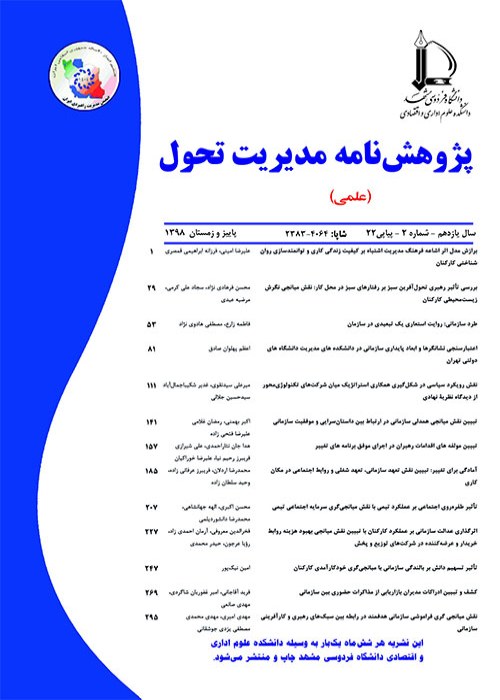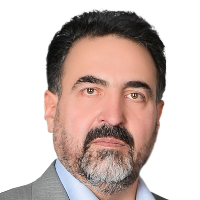Designing a Model for Corruption Reducing Structural Capital in the Banking Network Using Grounded Theory
Author(s):
Article Type:
Research/Original Article (دارای رتبه معتبر)
Abstract:
1-
2- THEORETICAL FRAMEWORK
Structural capital is a function of human capital and the determining factor of organizational form. On the other hand, structural capital is created openly and independently of human capital as soon as it is affected by human capital. For example, organizational structure and organizational culture can have fundamental independent effects. Therefore, structural and human capital help organizations interact with each other. The organization's mission and vision, core values, strategies, work systems, and internal processes, known as structural capital, play a vital role in preventing administrative and financial corruption and dramatically reducing the cost of fighting it. Therefore, the leading question of the research is how the structural capital in the banking network is formed to reduce corruption, what are the causal, contextual, and intervening factors for the formation of this capital, and what strategies can be used to reduce corruption and organizational health.
3-
4- RESULTS &
5- CONCLUSIONS & SUGGESTIONS
In general, it can be said that according to the extracted categories and the proposed research model, it can be concluded that to reduce and eliminate corruption in the banking system, it is necessary to revise the indicators of structural capital in organizations. They say What causes the reduction of administrative corruption is the design of correct, rational, and transparent systems and mechanisms, especially in sectors prone to corruption. In other words, proactive control in the form of structural capital is much more effective than retrospective control in dealing with administrative corruption. Therefore, this research provides insight into reducing administrative corruption, which is necessary to close the way to financial corruption using structural capital. Dealing with corruption after the commission of corruption is like an after-death cure. Proper structuring and developing the organization's structural capital is considered a strong barrier against corruption in the banking network.
INTRODUCTION
Organizations use various tools to control corruption and organizational misconduct. Some organizations take a passive approach and fight corruption, and some focus on proactive controls. In the meantime, the leading organizations to make the organization healthy include efficient operational processes, flexible and responsive structure to the environment, innovation atmosphere, and so on. They use what is known as structural capital. The present study used grounded theory to design a structural capital model to reduce corruption in the banking network.2- THEORETICAL FRAMEWORK
Structural capital is a function of human capital and the determining factor of organizational form. On the other hand, structural capital is created openly and independently of human capital as soon as it is affected by human capital. For example, organizational structure and organizational culture can have fundamental independent effects. Therefore, structural and human capital help organizations interact with each other. The organization's mission and vision, core values, strategies, work systems, and internal processes, known as structural capital, play a vital role in preventing administrative and financial corruption and dramatically reducing the cost of fighting it. Therefore, the leading question of the research is how the structural capital in the banking network is formed to reduce corruption, what are the causal, contextual, and intervening factors for the formation of this capital, and what strategies can be used to reduce corruption and organizational health.
3-
METHODOLOGY
This research is a qualitative study adopting an inductive paradigm. In the present study, semi-structured interviews were used as a data collection tool, and the resulting data were analyzed using open, central, and selective coding. In the qualitative part, purposeful sampling was used to conduct 21 interviews based on theoretical saturation. The findings were validated through the researcher's self-review and member control technique. The results of the research include the identification of causal, background, intervening factors, and the consequences of structural capital that reduces corruption and finally presents the final model of structural capital that reduces corruption in the banking network. Structural equation modeling software was used to validate the research model. Two hundred questionnaires were distributed among the available people, and finally, 190 well-qualified questionnaires were collected. The data collection tool was a researcher-made questionnaire, whose validity was confirmed by considering the opinions of several management professors.4- RESULTS &
DISCUSSION
The results indicate that the advances in information technology, the existence of several regulatory organizations, including the central bank, the desire of the country's top officials to fight corruption, the requirements of international organizations, anti-money laundering regulations, the law prohibiting interference of government employees and Basel banking standards were identified as the causal factors of structural capital that reduce corruption in the banking network.5- CONCLUSIONS & SUGGESTIONS
In general, it can be said that according to the extracted categories and the proposed research model, it can be concluded that to reduce and eliminate corruption in the banking system, it is necessary to revise the indicators of structural capital in organizations. They say What causes the reduction of administrative corruption is the design of correct, rational, and transparent systems and mechanisms, especially in sectors prone to corruption. In other words, proactive control in the form of structural capital is much more effective than retrospective control in dealing with administrative corruption. Therefore, this research provides insight into reducing administrative corruption, which is necessary to close the way to financial corruption using structural capital. Dealing with corruption after the commission of corruption is like an after-death cure. Proper structuring and developing the organization's structural capital is considered a strong barrier against corruption in the banking network.
Keywords:
Language:
Persian
Published:
Transformation Managemet Journal, Volume:15 Issue: 1, 2024
Pages:
40 to 72
magiran.com/p2679590
دانلود و مطالعه متن این مقاله با یکی از روشهای زیر امکان پذیر است:
اشتراک شخصی
با عضویت و پرداخت آنلاین حق اشتراک یکساله به مبلغ 1,390,000ريال میتوانید 70 عنوان مطلب دانلود کنید!
اشتراک سازمانی
به کتابخانه دانشگاه یا محل کار خود پیشنهاد کنید تا اشتراک سازمانی این پایگاه را برای دسترسی نامحدود همه کاربران به متن مطالب تهیه نمایند!
توجه!
- حق عضویت دریافتی صرف حمایت از نشریات عضو و نگهداری، تکمیل و توسعه مگیران میشود.
- پرداخت حق اشتراک و دانلود مقالات اجازه بازنشر آن در سایر رسانههای چاپی و دیجیتال را به کاربر نمیدهد.
In order to view content subscription is required
Personal subscription
Subscribe magiran.com for 70 € euros via PayPal and download 70 articles during a year.
Organization subscription
Please contact us to subscribe your university or library for unlimited access!



